Erik Buhmann
CaloChallenge 2022: A Community Challenge for Fast Calorimeter Simulation
Oct 28, 2024
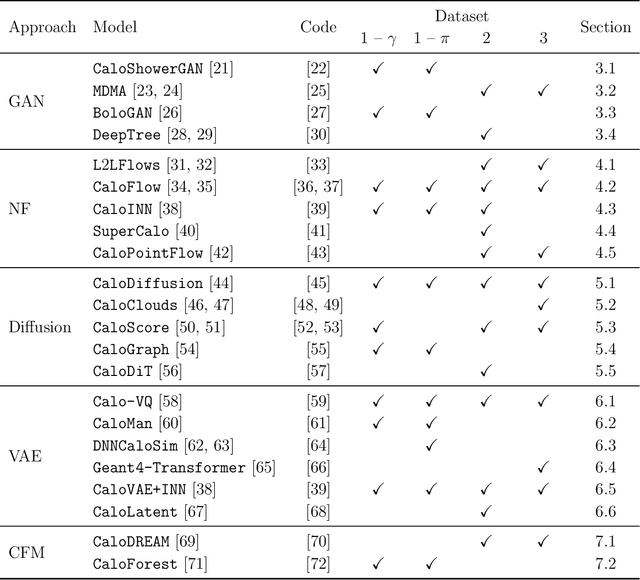
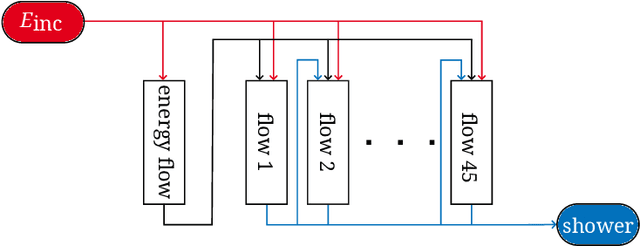
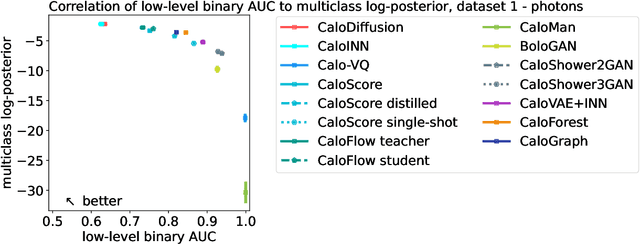
Abstract:We present the results of the "Fast Calorimeter Simulation Challenge 2022" - the CaloChallenge. We study state-of-the-art generative models on four calorimeter shower datasets of increasing dimensionality, ranging from a few hundred voxels to a few tens of thousand voxels. The 31 individual submissions span a wide range of current popular generative architectures, including Variational AutoEncoders (VAEs), Generative Adversarial Networks (GANs), Normalizing Flows, Diffusion models, and models based on Conditional Flow Matching. We compare all submissions in terms of quality of generated calorimeter showers, as well as shower generation time and model size. To assess the quality we use a broad range of different metrics including differences in 1-dimensional histograms of observables, KPD/FPD scores, AUCs of binary classifiers, and the log-posterior of a multiclass classifier. The results of the CaloChallenge provide the most complete and comprehensive survey of cutting-edge approaches to calorimeter fast simulation to date. In addition, our work provides a uniquely detailed perspective on the important problem of how to evaluate generative models. As such, the results presented here should be applicable for other domains that use generative AI and require fast and faithful generation of samples in a large phase space.
Flow Matching Beyond Kinematics: Generating Jets with Particle-ID and Trajectory Displacement Information
Nov 30, 2023Abstract:We introduce the first generative model trained on the JetClass dataset. Our model generates jets at the constituent level, and it is a permutation-equivariant continuous normalizing flow (CNF) trained with the flow matching technique. It is conditioned on the jet type, so that a single model can be used to generate the ten different jet types of JetClass. For the first time, we also introduce a generative model that goes beyond the kinematic features of jet constituents. The JetClass dataset includes more features, such as particle-ID and track impact parameter, and we demonstrate that our CNF can accurately model all of these additional features as well. Our generative model for JetClass expands on the versatility of existing jet generation techniques, enhancing their potential utility in high-energy physics research, and offering a more comprehensive understanding of the generated jets.
EPiC-ly Fast Particle Cloud Generation with Flow-Matching and Diffusion
Sep 29, 2023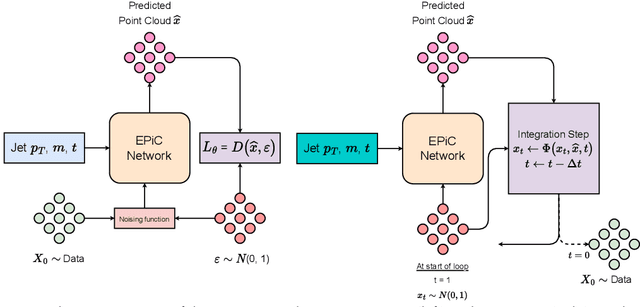
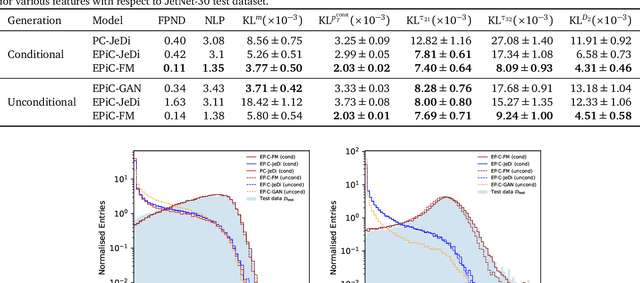
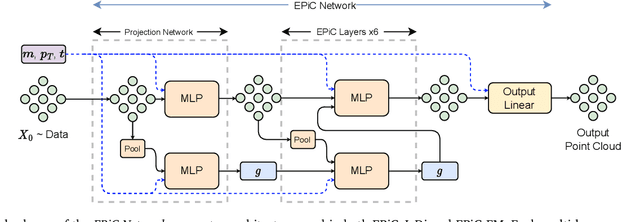

Abstract:Jets at the LHC, typically consisting of a large number of highly correlated particles, are a fascinating laboratory for deep generative modeling. In this paper, we present two novel methods that generate LHC jets as point clouds efficiently and accurately. We introduce \epcjedi, which combines score-matching diffusion models with the Equivariant Point Cloud (EPiC) architecture based on the deep sets framework. This model offers a much faster alternative to previous transformer-based diffusion models without reducing the quality of the generated jets. In addition, we introduce \epcfm, the first permutation equivariant continuous normalizing flow (CNF) for particle cloud generation. This model is trained with {\it flow-matching}, a scalable and easy-to-train objective based on optimal transport that directly regresses the vector fields connecting the Gaussian noise prior to the data distribution. Our experiments demonstrate that \epcjedi and \epcfm both achieve state-of-the-art performance on the top-quark JetNet datasets whilst maintaining fast generation speed. Most notably, we find that the \epcfm model consistently outperforms all the other generative models considered here across every metric. Finally, we also introduce two new particle cloud performance metrics: the first based on the Kullback-Leibler divergence between feature distributions, the second is the negative log-posterior of a multi-model ParticleNet classifier.
CaloClouds II: Ultra-Fast Geometry-Independent Highly-Granular Calorimeter Simulation
Sep 11, 2023Abstract:Fast simulation of the energy depositions in high-granular detectors is needed for future collider experiments with ever increasing luminosities. Generative machine learning (ML) models have been shown to speed up and augment the traditional simulation chain in physics analysis. However, the majority of previous efforts were limited to models relying on fixed, regular detector readout geometries. A major advancement is the recently introduced CaloClouds model, a geometry-independent diffusion model, which generates calorimeter showers as point clouds for the electromagnetic calorimeter of the envisioned International Large Detector (ILD). In this work, we introduce CaloClouds II which features a number of key improvements. This includes continuous time score-based modelling, which allows for a 25 step sampling with comparable fidelity to CaloClouds while yielding a $6\times$ speed-up over Geant4 on a single CPU ($5\times$ over CaloClouds). We further distill the diffusion model into a consistency model allowing for accurate sampling in a single step and resulting in a $46\times$ ($37\times$) speed-up. This constitutes the first application of consistency distillation for the generation of calorimeter showers.
CaloClouds: Fast Geometry-Independent Highly-Granular Calorimeter Simulation
May 08, 2023Abstract:Simulating showers of particles in highly-granular detectors is a key frontier in the application of machine learning to particle physics. Achieving high accuracy and speed with generative machine learning models would enable them to augment traditional simulations and alleviate a major computing constraint. This work achieves a major breakthrough in this task by, for the first time, directly generating a point cloud of a few thousand space points with energy depositions in the detector in 3D space without relying on a fixed-grid structure. This is made possible by two key innovations: i) using recent improvements in generative modeling we apply a diffusion model to generate ii) an initial even higher-resolution point cloud of up to 40,000 so-called Geant4 steps which is subsequently down-sampled to the desired number of up to 6,000 space points. We showcase the performance of this approach using the specific example of simulating photon showers in the planned electromagnetic calorimeter of the International Large Detector (ILD) and achieve overall good modeling of physically relevant distributions.
EPiC-GAN: Equivariant Point Cloud Generation for Particle Jets
Jan 17, 2023Abstract:With the vast data-collecting capabilities of current and future high-energy collider experiments, there is an increasing demand for computationally efficient simulations. Generative machine learning models enable fast event generation, yet so far these approaches are largely constrained to fixed data structures and rigid detector geometries. In this paper, we introduce EPiC-GAN - equivariant point cloud generative adversarial network - which can produce point clouds of variable multiplicity. This flexible framework is based on deep sets and is well suited for simulating sprays of particles called jets. The generator and discriminator utilize multiple EPiC layers with an interpretable global latent vector. Crucially, the EPiC layers do not rely on pairwise information sharing between particles, which leads to a significant speed-up over graph- and transformer-based approaches with more complex relation diagrams. We demonstrate that EPiC-GAN scales well to large particle multiplicities and achieves high generation fidelity on benchmark jet generation tasks.
Shared Data and Algorithms for Deep Learning in Fundamental Physics
Jul 01, 2021
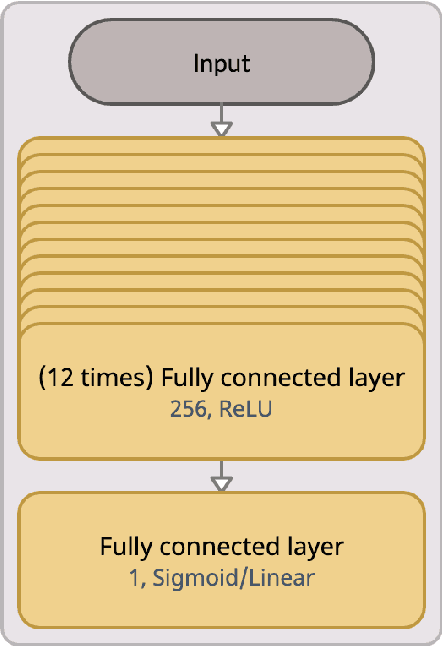
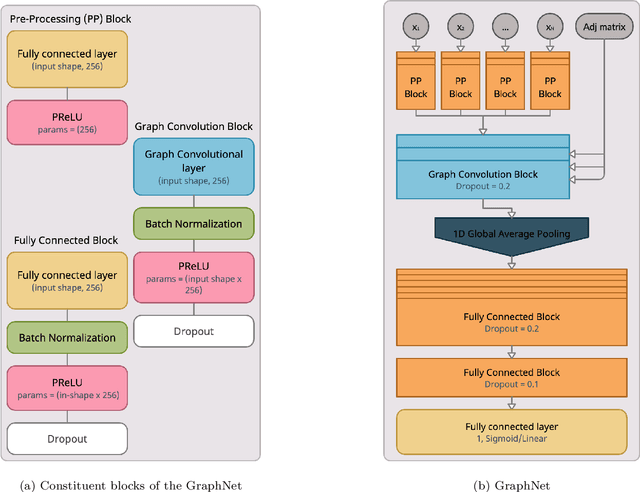

Abstract:We introduce a collection of datasets from fundamental physics research -- including particle physics, astroparticle physics, and hadron- and nuclear physics -- for supervised machine learning studies. These datasets, containing hadronic top quarks, cosmic-ray induced air showers, phase transitions in hadronic matter, and generator-level histories, are made public to simplify future work on cross-disciplinary machine learning and transfer learning in fundamental physics. Based on these data, we present a simple yet flexible graph-based neural network architecture that can easily be applied to a wide range of supervised learning tasks in these domains. We show that our approach reaches performance close to state-of-the-art dedicated methods on all datasets. To simplify adaptation for various problems, we provide easy-to-follow instructions on how graph-based representations of data structures, relevant for fundamental physics, can be constructed and provide code implementations for several of them. Implementations are also provided for our proposed method and all reference algorithms.
 Add to Chrome
Add to Chrome Add to Firefox
Add to Firefox Add to Edge
Add to Edge